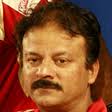Indian Vs England, 2nd Test, Trent Bridge, 1st August 2011, pre match start Day 4.
A positive approach, no less by the England late order may have tilted the scales in favour of the hosts. Was this the big session that has already decided the course of the match?
The curious Indian fan will probably do a post mortem of how England mustered up 221 in the first innings even after India had felled them to 124 for 8! This allowed India a lead of only 67. The last two wickets, that is the last three batsmen for England, Stuart Broad no less probably adopted a carefree attitude, best remembered by that nation as one displayed by their tailenders during the famous series in 1981 against Australia, now affectionately titled Botham's Ashes.
Mercurial all-rounder Ian Botham led England from certain defeat to win the match but not without a significant stand with tailender Graham Dilley when the match was virtually lost. The psyche adopted was that nothing could get worse so we might has swing our bat to have some fun. This helped rid off any nervous tension and the ball evaded the Australian fielders with regularity and found the boundary. It was only when Dilley, better known for his bowling, realised that 117 runs had been put on and more could be done that he made the fatal mistake of playing with care. The result was that his lost his wicket and the tail's resistance ended. In hindsight Botham and others analysing the situation said it had been a wrong thing to do to 'comply with reality' whereas with the carefree attitude even more runs may have resulted.
Anyway, the Englishmen then had done enough damage and Botham and Willis bowled strongly to defeat Australia.
The current day's perspective is of course more professional after so many years and opportunities to analyse innings. Most teams tell their latter order to go after the leather, that is, get runs fast because inevitably the end will come. It seems the best tactic to adopt but few would have guessed at Trent Bridge that England's last two wickets would put on almost 80 % more runs than the top and middle orders had done.
By Vikram Afzulpurkar
A positive approach, no less by the England late order may have tilted the scales in favour of the hosts. Was this the big session that has already decided the course of the match?
 |
| Stuart Broad scored 64 at number 9. |
Mercurial all-rounder Ian Botham led England from certain defeat to win the match but not without a significant stand with tailender Graham Dilley when the match was virtually lost. The psyche adopted was that nothing could get worse so we might has swing our bat to have some fun. This helped rid off any nervous tension and the ball evaded the Australian fielders with regularity and found the boundary. It was only when Dilley, better known for his bowling, realised that 117 runs had been put on and more could be done that he made the fatal mistake of playing with care. The result was that his lost his wicket and the tail's resistance ended. In hindsight Botham and others analysing the situation said it had been a wrong thing to do to 'comply with reality' whereas with the carefree attitude even more runs may have resulted.
 |
| Graham Dilley's unexpected shots in 1981 had upped England's chances |
The current day's perspective is of course more professional after so many years and opportunities to analyse innings. Most teams tell their latter order to go after the leather, that is, get runs fast because inevitably the end will come. It seems the best tactic to adopt but few would have guessed at Trent Bridge that England's last two wickets would put on almost 80 % more runs than the top and middle orders had done.
The moral of the story is that provided you adopt the right attitude, luck may favour you to the extent it did the Englishmen two days ago in Nottingham. Now, with a massive second innings lead of about 380 (four wickets in hand) before the start of the 4th day's play, the English seemed to have done something very right early on in the match, namely the positive approach adopted in the first innings.














